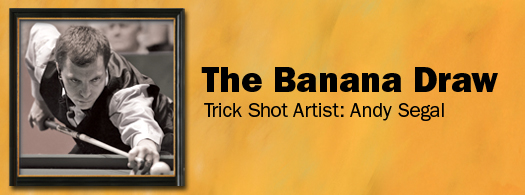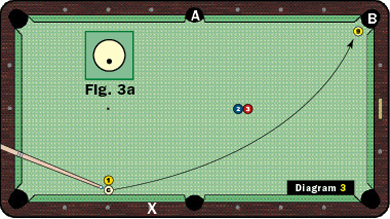
THIS SHOT is called the "Banana Draw" shot. I don't know the inventive player who thought this one up, but I'm guessing it came from a real in-game situation. The cue ball escapes a rather troublesome position frozen to the rail and 1 ball. With the correct combination of spin, speed and aim, you can bend the cue ball around the various obstacles to make the 9 ball in the top left corner pocket.
The Shot
The Banana Draw might look like something designed solely for trick shot exhibitions, but a situation like this might come up in your next 8-ball or 9-ball match. When most players kick at a ball, they try to figure out the natural angle. But what happens if that natural angle is blocked? You can apply the concept seen here by aiming a little longer and using backspin.
 The Setup
The Setup
As you can see in Diagram 3, the cue ball is frozen to the second diamond on the long rail, with an object ball frozen to the cue ball. Two blocker balls are then placed in the center of the table length-wise along the diamond to the right of the side pockets. Leave the 9 ball hanging in the top left corner pocket.
The Execution
You might first wonder how the cue ball escapes being frozen to the 1 ball and the rail. The answer: You are aiming into the rail. If you gently tap the cue ball, it will hit the 1. If you shoot through the cue ball and push your cue into the rail, however, the force of the cue ball will compress the cushion just enough for it to move without disturbing the 1 ball.
The second problem is getting the cue ball around the 2 and 3, which are blocking a straight route to the 9. The key here is hitting the cue ball with draw. Start by aiming at the third diamond on the long rail (marked by the "X" in Diagram 3). Aiming below center on the cue ball (1 1/2 tips of draw works for me), the cue ball will be spinning toward pocket A as it passes the 2 and 3 balls. This is similar to a masse shot, where the cue ball is rolling in one direction and spinning in another. At some point, the friction will overtake the momentum and the cue ball will change direction, hopefully heading toward pocket B. Exactly when the cue ball curves depends on how hard and how low you hit the cue ball.
Two Tips
- The key to this shot is finding the perfect mix of speed and spin. If the cue ball hits the 1 ball, either aim farther down-table or hit the cue ball harder (which will compress the rail more); if you cue ball hits the short rail, use more draw or a softer stroke; if the cue ball hits the 2 or 3, less draw or more power.
- When making adjustments (in spin, power or aim), one thing at a time, so you get an idea of how much change affects the shot.





